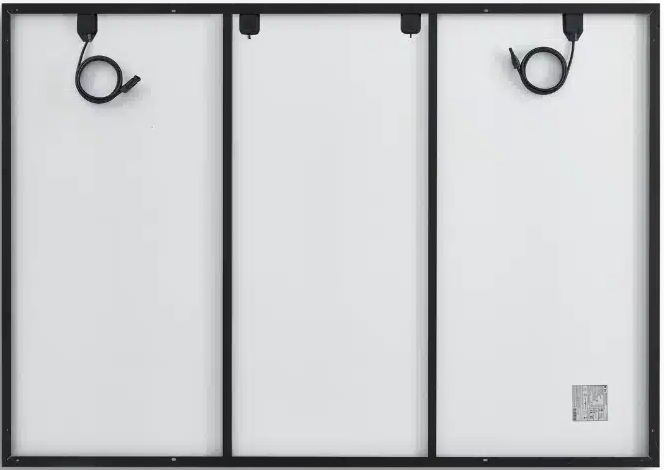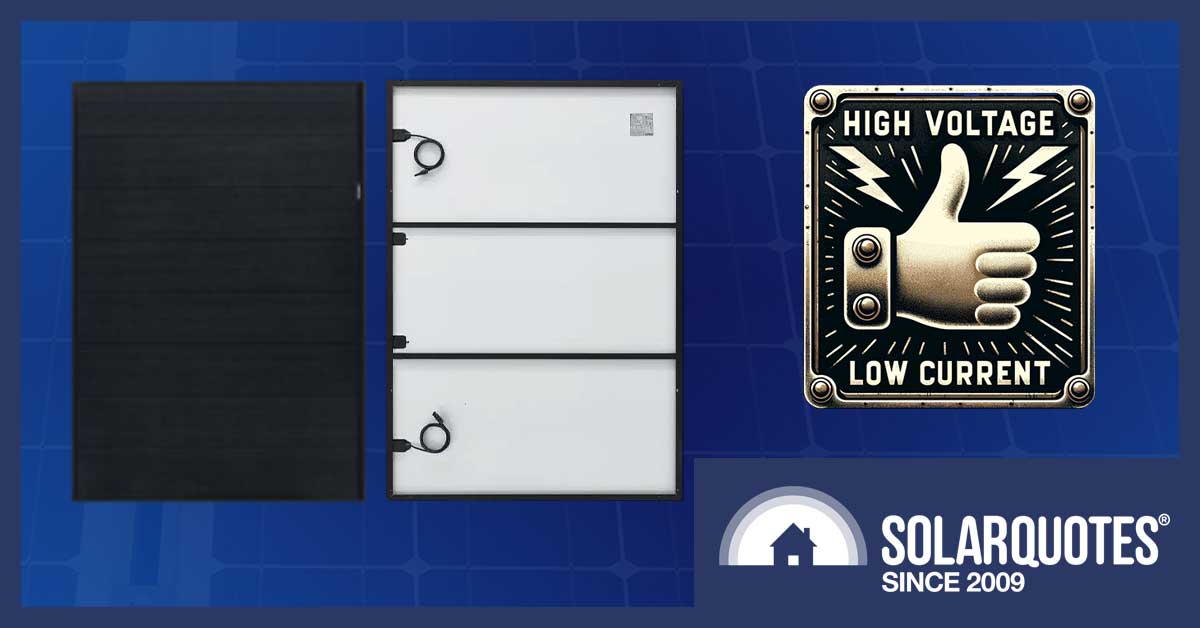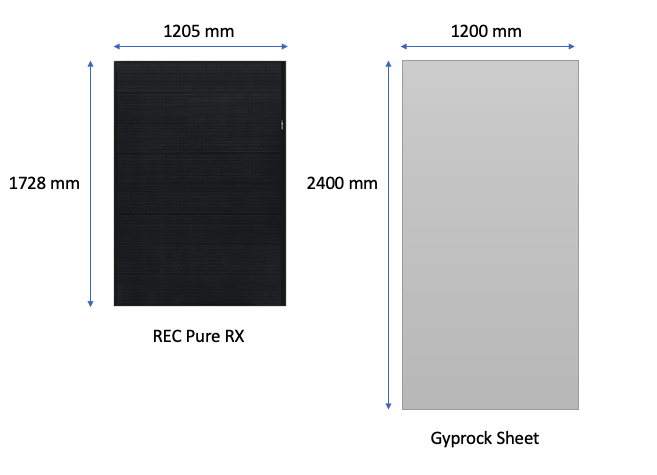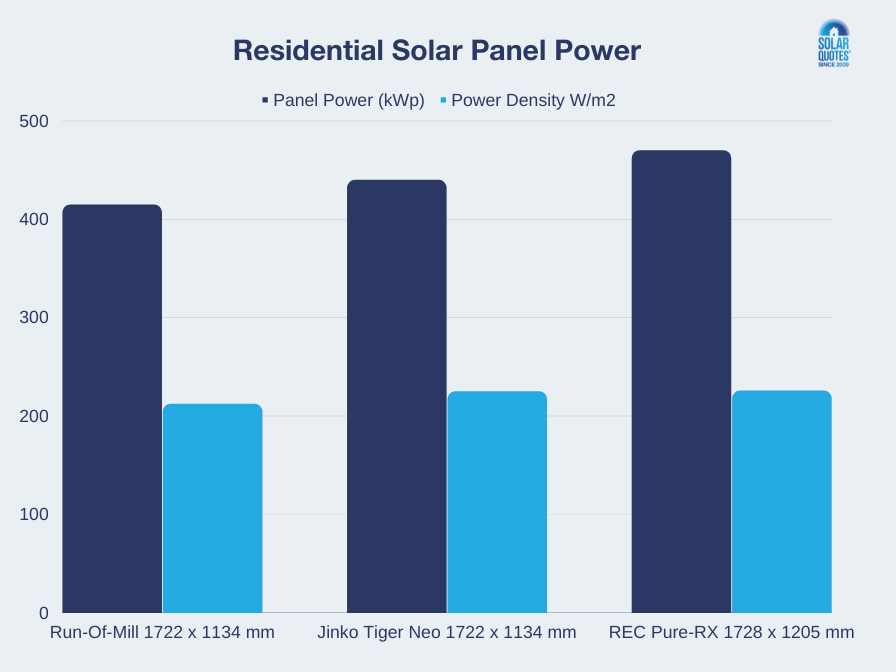Prominent Singapore-headquartered PV module manufacturer REC has dropped the specifications of its latest line of residential solar panels, the REC Alpha Pure-RX Series. The “pure” part of this name refers to the panels being lead-free.
Using heterojunction cell technology (HJT), these modules represent yet another significant step in residential solar power. Beyond the marketing spin, the real issue? Installers grappling with bigger, bulkier panels.
While they’re similar in height to many other residential solar panels, they’re wider. For instance, Jinko has a 440w panel measuring 1722 x 1134 mm, while many others offer 415w for that size. The new REC panels, however, are 1728mm tall and 1205mm wide, making them broader than a standard sheet of gyprock. It’s good to see that they’re also stating the size as 2.08m², a detail more manufacturers should include.
- Run of the mill is now 212.52W/m²
- Jinko Tiger Neo is 225.32W/m²
- REC Pure-RX is 225.96W/m²
So, roughly speaking, the headline is 7% or 30 watts more per panel, but it’s only a tiny fraction better in actual efficiency when you compare the power density.
REC Alpha Pure-RX Series Specifications:
- Power ratings ranging from 450 W to 470 W
- Impressive efficiencies, ranging from 21.6% to 22.6%.
- 88 heterojunction, half-cut monocrystalline solar cells,
- High output voltage, low current
- Four bypass diodes, meaning 11 of the 88 cells can be bypassed at a time, helping maintain power when shaded.
- Sturdy build: Each module weighs approximately 23 kg, but REC have two reinforcement bars across the back, which helps with strength, wind loading and cable management. I would buy them on that point alone.

I’m sure some installers will be confronted by the cables on one side.
- Temperature resilience: With an operating temperature coefficient of -0.24% per ºC, these modules remain efficient even in high summer heat.
Finn explains temperature resilience of solar panels here:
Warranty Assurance:
- REC ProTrust Warranty if using a REC-certified installer: This extends coverage for up to 25 years, encompassing product, performance, and labour. Notably, it ensures a guaranteed power output of at least 92%, even in the 25th year.
| REC ALPHA PURE-RX SOLAR PANEL TECHNICAL SPECIFICATIONS | |
|---|---|
| Cell type: | 88 half-cut REC heterojunction cells with lead-free, gapless technology |
| Glass: | 3.2 mm solar glass with anti-reflective surface treatment per EN12150 |
| Backsheet: | Polymer |
| Frame: | Anodized aluminium (black) |
| Junction box: | 4-part, 4-bypass diodes, lead-free IP68 rated, per IEC 62790 |
| Connectors: | Stäubli MC4 PV-KBT4/KST4(4 mm²) in accordance with IEC 62852, IP68 only when connected |
| Cable: | 4 mm² solar cable, 1.7 + 1.7 m in accordance with EN50618 |
| Dimensions: | 1728 x 1205 x 30 mm (2.08 m²) |
| Weight: | 23.2 kg |
| Origin: | Made in Singapore |
The Real REC Alpha Pure-RX Difference
Let’s examine the critical specifications rather than inundating you with sales rhetoric. You’ll have to excuse me while I go into some nerdy details that installers will be joyfully clutching pearls about.
Voltage and Current
These panels operate at a relatively high voltage ( ~65 VOC) and a relatively low current (~9A ISC). Why this offers advantages in Australia warrants its own forthcoming blog post. But here’s a brief rundown on how it simplifies the solar installer/designer’s job:
High Voltage is a significant advantage over the recent flood of low-voltage, high-current 108 half-cell panels on the market. While modern inverters are very flexible, they always work better with a higher input voltage.
Low currents mean these modules would be perfectly suited to microinverters like the Enphase IQ7a, except they can’t tolerate the high open circuit voltage. The IQ7x is the only Enphase that will handle 65 VOC, but low rated wattage means you can’t claim STC credits. 1
Higher voltage and lower current also mean the potential to be more flexibly deployed in short parallel strings on conventional inverters. That’s handy for dealing with Australia’s love affair with complex roofs.
A full datasheet for REC Alpha Pure-RX solar panels can be viewed here.
Finally, We Have A Contender
Solar panels have been growing in both physical width and current output for a long time, while inverter makers have not kept up. Rather, they have been muddling along. In jurisdictions like Australia, they have been forced to make special declarations that they really can handle all that current.
We have what some would argue is an overly conservative standard, which has been met with some hastily written paperwork saying, “Yeah, it’s fine.”
This new REC Alpha Pure-RX solar panel puts things right by taking the growth in panel capacity and turning it into voltage instead of current.
All we need now is for AS4777 to catch up so we can put up to 1000V DC on your residential roof.
REC solar panels have been popular among Australian installers. In this year’s SolarQuotes’ Installers Choice Awards, REC scored gold in the best solar panels in 2023 category; and also gold for the best after-sales support.
Footnotes
- Apologies to the Enphase fans out there for getting your hopes up about a “perfect” panel for the IQ7a. With too many tabs open, I made an error; the 470w just isn’t Enphase friendly ↩




 RSS - Posts
RSS - Posts



Hi Anthony – how can these be suited to an IQ7A micro when the Voc is so high? IQ7A-72-2-INT has a max input voltage of 58V , and these modules have a Voc of 65V ?
I’ve been waiting for a while for an REC module that’s good for Enphase, and this appears no better unfortunately….
Hi Geoff,
I think it must have been a typo.
And, you are absolutely right as I have pointed out below as well.
“I’ve been waiting for a while for an REC module that’s good for Enphase”
Damn straight. The IQ7X only supports up to 420W panels (with high voltage and low current). It will work well with and up to 420W Alpha Pure-R panels.
You will need to wait for the IQ8X-BAT for pairing an Alpha Pure-RX panel with if it ever lands down under. As usual, we Aussies always get shafted when it comes to the latest and greatest.
Hi Geoff,
You’re right. I’ve swapped the VOC for VMP figure and thought we had a winner finally. Wattage wise they’re perfect (366VA ÷ 0.75 = 488) same too for current.
Serves me right for working on two articles and a customer complaint about Enphase simultaneously.
We’ll blame the editor and detail more about the cruel mistress Enphase next week.
Cheers
“Low currents mean these modules will be perfectly suited to microinverters like the Enphase IQ7A, where many 108 half-cell panels simply aren’t compatible.”
I think you meant to say IQ7X, and not IQ7A.
Due to their high open circuit voltage, the Alpha Pure-R and the Alpha Pure-RX are not compatible with any Enphase MIs other than IQ7X and IQ8X-BAT (not available in Australia).
Since the IQ7X emit lower continuous power output (315 VA), you get some nice inverter oversizing when paired with the REC-420AA Pure-R (Ratio = 1.33).
Another thing that is worthwhile mentioning about the Alpha Pure-R and the Alpha Pure-RX is their industry leading front load resistance (7 kPa), and rear load/wind resistance (4 kP).
I cannot think of any other solar panels that possess such traits.
Oooh, these panels could allow me to increase PV yield by ~15% over the REC 410W units I’d pencilled in. As you say, the extra rigidity is reassuring as atmospheric energy levels increase, year by year.
BUT, on the 23 m long north facing roof there’s just 2.7m upslope run, as it’s tilted 40 degrees. Let’s say 2700 – 2*1205 – 10 = 280 mm to split above & below the array of two landscape rows of 12 panels each. Is it OK to be just 140 mm away from the ridge, on a steel decking roof, down here in Victoria?
Mounted low, parallel with the roof, seems safer than the high angle racking often seen, even if we sneak close to the ridge, so long as clamping is proportionate?
Incidentally, REC Alpha Pure also score gold in my book, as they’re Pb free, and I’m on tank water for all domestic purposes. Other panels _might_ be OK, as there shouldn’t be water dripping from the connection box under the panel, and the rest is sealed.
If these can be wangled in, then who says procrastination doesn’t pay?
Many thanks for the “heads up”, Anthony. This is worth knowing.
Hi Erik,
I always say wattage is for winners and rules are for whingers. You’ll be fine with a landscape array and a good installer.
https://www.solarquotes.com.au/blog/panel-exclusion-zones/
Sorry absolute beginner here so please excuse ignorance!
If i wanted to get the Rec Alpha pure panels what inverter can i use if not enforce?what about STcs?
many thanks
Hi Rowena,
REC Alphas are a great panel but many people are frustrated that Enphase aren’t all they’re cracked up to be. Literally every other string inverter on the market will be well suited to these panels. I’d look at Fronius, Sungrow and GoodWe just to name a few.
Start by looking at the “Good Solar Guide” then maybe some of our 101 videos on youtube as well as the FAQ seection.
Hi Anthony,
REC Alpha Pure-R 410W and 420W panels (430W panels are not available in AU) pair well with the Enphase IQ7X (315VA continuous power).
I have double and triple checked with both REC Group and Enphase Australia.
There have been many installations using the above combination as I have been told by more than one REC Certified Installer in Melbourne.
Under ideal conditions, there could be potential clipping as the IQ7X MIs are somewhat underpowered. Other than that do you see any major issues with the above pairing?
I am asking this question as a family member is about to embark on a similar solar installation on a hybrid roof structure (where Enphase MIs make more sense than a string inverter).
Hi Sam,
315 x 0.75 = 420
420w is the limit in terms of claiming STC incentives in Australia if you’re using a 315w inverter, so yes you can use them and yes they will clip in the same way that a 13.5 amp rated panel will clip if connected to an IQ7a.
Sadly the IQ7x, with it’s weedy current capacity, is the only Enphase unit capable of handing a higher voltage module.
You may have better luck/yield with an IQ8 and a higher current module.
Thank you for your reply, Anthony.
Greatly appreciate it.
Interestingly enough, the 430W Alpha Pure-Rs haven’t even reached our shores yet.
They won’t be compatible with any Enphase MIs we can get our hands on in Australia.
“You may have better luck/yield with an IQ8 and a higher current module.”
Unless I am reading the panel specs incorrectly, the open circuit voltage of the Alpha Pure-R (and RX) panels are outside the range for IQ8AC and IQ8HC.
IQ8X-BAT-US should be compatible. However, it is a pre-release unit, and has a maximum continuous output power of 315 VA. No better than the IQ7X.
As far as I can see, IQ7X is as good as it gets for the REC Alpha Pure-R 410W & 420W panels.
In the mean time, Enphase needs to come up with a much more powerful MI with high operating voltage for pairing with the REC Alpha Pure-RX.
Happy to advise the REC Alpha Pure RX 460W panels are now available in Australia, and can be paired with the newly released Enphase IQ 8X.
Thanks Graham,
The Enphase fans will be really happy about that. What are the key specs for voltage and current?
Hi Anthony,
The Enphase IQ8X has a Maximum Input Voltage of 79.5, Maximum Input Current of 10A and Maximum apparent power of 384 VA
The Alpha Pure RX 460W has Open Circuit Voltage of 65.3V and Short Circuit Current of 8.38A